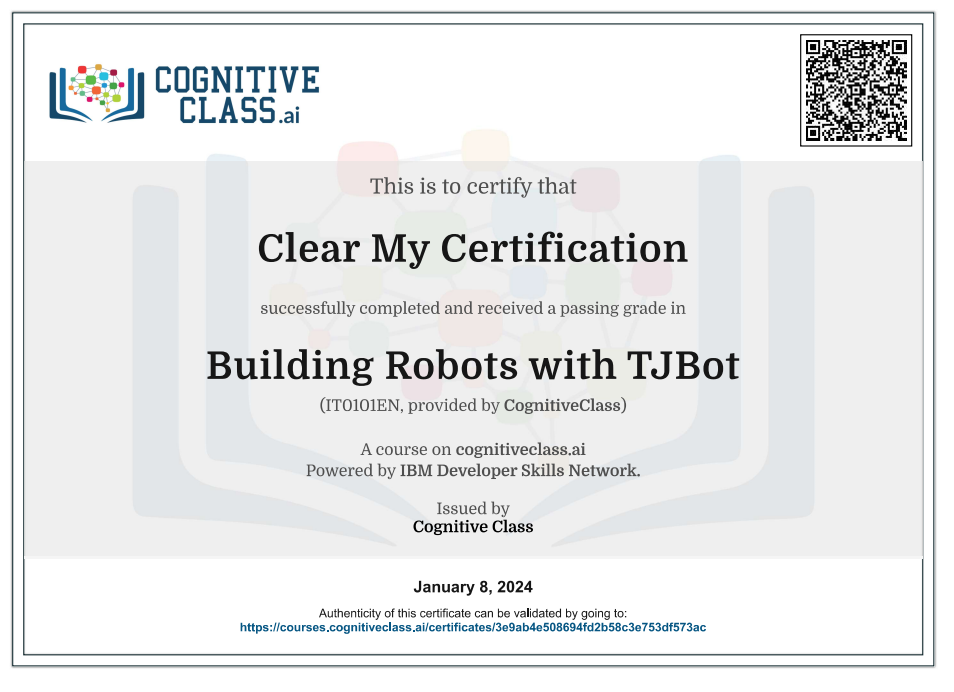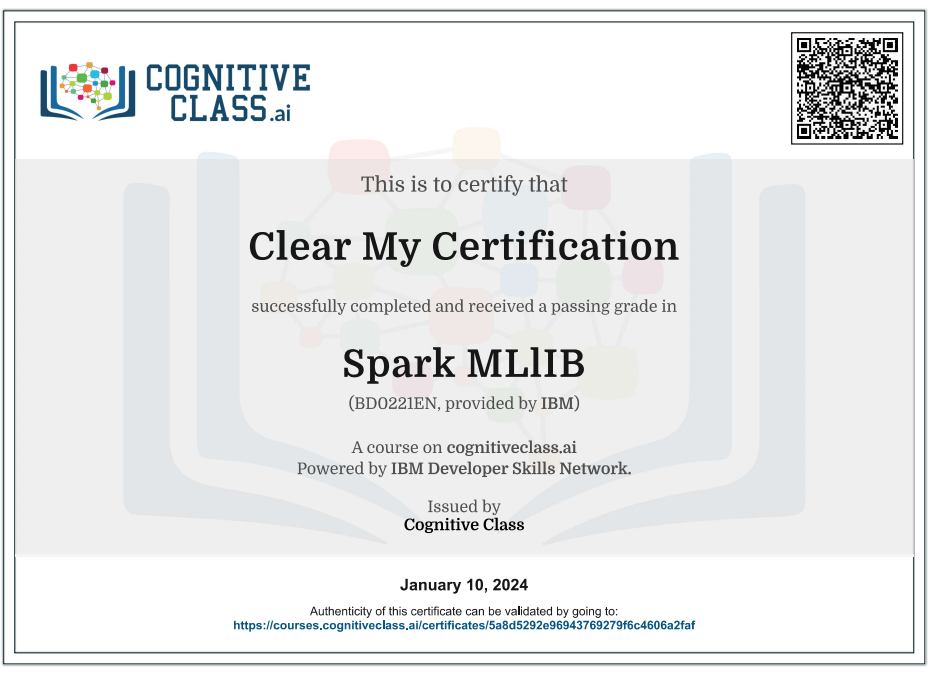Enroll Here: Building Robots with TJBot Cognitive Class Exam Quiz Answers
Building Robots with TJBot Cognitive Class Certification Answers

Quick Labs Quiz Answers – Cognitive Class
Question 1: What does the see method return? Select all that apply.
- Names of objects
- Names of colors
- Names of people
- An image taken with the camera
Question 2: Which of these statements are true about TJBot? Select all that apply.
- TJBot is a product sold by IBM.
- TJBot is an open-source project.
- TJBot is powered by artificial intelligence.
- TJBot has a community of contributors who contribute recipes.
Question 3: What programming languages are supported by the TJBot libraries mentioned in this course? Select all that apply.
- Node.js
- Node-RED
- Swift
- Python
Question 4: Which one of these Watson services does not have a corresponding method in the TJBot library.
- Speech to Text
- Language Translator
- Discovery
- Text to Speech
- Visual Recognition
- Watson Assistant
- Tone Analyzer
Question 5: Which method can be passed a duration value to specify how long the LED light should stay on?
- shine
- blink
- pulse
- turnOn
Complex Labs Quiz Answers – Cognitive Class
Question 1: In which order do these methods described in the course make the most logical sense?
- isTranslatable, identifyLanguage, translate
- translate, identifyLanguage, isTranslatable
- identifyLanguage, isTranslatable, translate
- isTranslatable, translate, identifyLanguage
Question 2: var TJBot = require(“tjbot”);
var tj = new TJBot(
[“camera”],
{},
{
visual_recognition: {
apikey: “”
}
});
tj.see(function(response) {
console.log(response);
});
- Names of people
- An array of objects containing names of objects and colors seen by the TJBot camera
- An image captured by TJBot
- Faces of people
Question 3: Which number points in the following Node.js code (#1, #2, #3, #4) should be corrected so that TJBot can say “Hello World” in English? Select all that apply.
var TJBot = require(“tjbot”);
var tj = new TJBot(
[“microphone”], // #1
{
robot: {
gender: “female” // #2
},
speak: {
language: “fr-FR” // #3
}
},
{
text_to_speech: { // #4
username: “cf63b1f3-ef18-4628-86c8-6b1871e076b9”,
password: “MWNwz3qcdIab”
}
});
tj.speak(“Hello World”);
- #1
- #2
- #3
- #4
Question 4: Review the following Node.js code. Which number points (#1, #2, #3, #4) in the following code should be corrected to make TJBot take a picture and speak out what is seen? Select all that apply.
var TJBot = require(“tjbot”);
var tj = new TJBot(
[“speaker”], // #1
{
robot: {
gender: “female” // #2
},
speak: {
language: “en-US” // #3
}
},
{ // #4
text_to_speech: {
username: “cf63b1f3-ef18-4628-86c8-6b1871e076b9”,
password: “MWNwz3qcdIab”
}
});
tj.see(function(response) {
tj.speak(“I see “+response.map(i => i.class).join(“, “));
});
- #1
- #2
- #3
- #4
Question 5: Which of the following blocks will speak out the phrase “Hello World” followed by pulsing the LED light the color green?
CODE BLOCK 1:
tj.speak(“hello world”).then(function() {
tj.pulse(“green”, 1);
});
CODE BLOCK 2:
tj.speak(“hello world”);
tj.pulse(“green”, 1);
CODE BLOCK 3:
tj.speak(“hello world”).then(function() {
tj.pulse(1, “green”);
});
CODE BLOCK 4:
tj.pulse(“green”, 1);
tj.speak(“hello world”);
- CODE BLOCK 1
- CODE BLOCK 2
- CODE BLOCK 3
- CODE BLOCK 4
Building Robots with TJBot Final Exam Answers – Cognitive Class
Question 1: What is the best way to determine whether a model is available in the Watson Language Translator service?
- Use the translate method
- Use the isTranslatable method
- Check the Watson Language Translator documentation
Question 2: The TJBot capabilities can be extended both physically and in code by using third-party libraries or by writing custom code.
- True
- False
Question 3: The converse method can be used to do which tasks? Select all that apply.
- Parse and process natural language
- Have TJBot respond by voice
- Provide a response to a user’s natural language input
- Extract intents and entities trained in Watson Assistant
Question 4: TJBot can recognize the verbal emotions by using the method analyzeTone.
- True
- False
Question 5: Which methods can be chained together with the converse method? Select all that apply.
- listen
- speak
- translate
- analyzeTone
Question 6: What is the correct order of the following three arguments that are passed to the TJBot constructor?
1. Hardware, a JavaScript array of strings, i.e. speaker, microphone, camera
2. A JavaScript object with Watson service credentials
3. A JavaScript object with configuration settings like the language to speak
Select an option
- #1 #3 #2
- #1 #2 #3
- #3 #2 #1
- #2 #1 #3
Question 7: Jane wrote this code in Node.js, but the code is not working as expected. Which number points in the code identify the code that should be corrected? Select all that apply.
var TJBot = require(“tjbot”);
var tj = new TJBot(
[“speaker”], // #1
{
listen: {
language: “en-US” // #2
}
},
{
speech_to_text: {
username: “”, // #3
password: “” // #4
}
});
tj.listen(function(text) {
console.log(text);
});
tj.stopListening(); // #5
- #1
- #2
- #3
- #4
- #5
Question 8: Select all the core hardware that is supported by TJBot by default.
- Raspberry Pi
- Microphone
- Thermometer
- Speaker
- Camera
- LED light
- Servo
Question 9: What is the variable workspaceId used for in the following code?
var TJBot = require(“tjbot”);
var tj = new TJBot(
[“microphone”,”speaker”],
{
robot: {
gender: “male”
},
speak: {
language: “en-US”
}
},
{
speech_to_text: {
username: “”,
password: “”
},
conversation: {
username: “”,
password: “”
},
text_to_speech: {
username: “cf63b1f3-ef18-4628-86c8-6b1871e076b9”,
password: “MWNwz3qcdIab”
}
}
);
var workspaceId = “”;
function processText(text) {
console.log(text);
tj.stopListening();
tj.converse(workspaceId, text, response => {
console.log(response);
tj.speak(response.object.output.text.join(” “)).then(function(){
tj.listen(processText);
});
});
}
tj.listen(processText);
- It segregates multiple user’s conversations with TJBot.
- It references a specific Watson Assistant service instance workspace that processes the natural language input
- It is an identifier that is used to continue the interaction with a single user over multiple calls
Question 10: Review the following code. Then, review the code blocks. Select the code block number that you must change to add in the placeholder labeled TODO to complete this program?
var TJBot = require(“tjbot”);
var tj = new TJBot(
[“camera”,”speaker”],
{
robot: {
gender: “male”
},
speak: {
language: “en-US”
}
},
{
// TODO: answer the question
text_to_speech: {
username: “”,
password: “”
}
});
tj.see(function(objects) {
console.log(objects);
var text = “T J Bot sees ” + objects.map(item => item[“class”]).join(“, “);
console.log(text);
tj.speak(text);
});
CODE BLOCK 1
visual_recognition: {
username: “”,
password: “”
},
CODE BLOCK 2
visual_recognition: {
apikey: “”
},
CODE BLOCK 3
No code changes are required. This program will run correctly without any changes.
- CODE BLOCK 1
- CODE BLOCK 2
- CODE BLOCK 3
Introduction to Building Robots with TJBot
Building robots with TJBot is an exciting and educational experience. TJBot is an open-source project created by IBM that provides a kit and set of instructions for building a small, programmable robot using a Raspberry Pi and various components. TJBot is designed to showcase how artificial intelligence (AI) and cognitive computing technologies can be integrated into a robot. Here’s a basic guide to get you started with building robots using TJBot:
1. Get the TJBot Kit:
- Acquire the TJBot kit, which typically includes a Raspberry Pi, a cardboard or 3D-printed robot frame, a servo motor, LEDs, a microphone, a speaker, and other components.
2. Set Up the Raspberry Pi:
- Follow the instructions provided in the TJBot documentation to set up the Raspberry Pi. This involves installing the operating system, configuring the network, and updating the software.
3. Assemble the Robot:
- Assemble the physical components of the robot according to the instructions in the TJBot kit. This may involve attaching the servo motor, LEDs, microphone, and speaker to the robot frame.
4. Connect the Electronics:
- Connect the electronic components to the Raspberry Pi. This includes wiring the servo motor, LEDs, microphone, and speaker to the appropriate GPIO pins on the Raspberry Pi.
5. Install TJBot Software:
- Install the TJBot software and libraries on the Raspberry Pi. This software includes Node.js modules and Python scripts that enable TJBot to interact with various services and APIs.
6. Explore Cognitive Services:
- TJBot is designed to showcase the integration of AI and cognitive computing services. Explore the different cognitive services provided by IBM Watson, such as natural language processing, image recognition, and text-to-speech.
7. Program TJBot:
- Write programs or scripts to control TJBot using Node.js or Python. Use the TJBot API to access the robot’s sensors and actuators. Experiment with creating interactive behaviors and responses.
8. Experiment with Watson Services:
- Integrate TJBot with IBM Watson services to add AI capabilities to the robot. For example, you can create a chatbot using Watson Assistant, enable speech recognition with Watson Speech to Text, or analyze images with Watson Visual Recognition.
9. Customize Behaviors:
- Customize TJBot’s behaviors based on your preferences and creativity. You can program the robot to respond to specific voice commands, change LED colors based on emotions, or perform dance moves with the servo motor.
Building robots with TJBot is a hands-on way to explore robotics, AI, and cognitive computing. It’s a great way to learn about hardware, software, and the integration of AI technologies in a fun and interactive way.
 Clear My Certification All Certification Exam Answers
Clear My Certification All Certification Exam Answers



